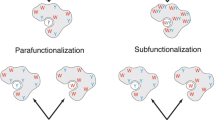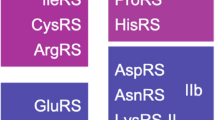Abstract
Sequence data and evolutionary arguments suggest that a similarity may exist between the C-terminal end of glutaminyl-tRNA synthetase (GlnRS) and the catalytic domain of glutamine amidotransferases (GATs). If true, this would seem to imply that the amidation reaction of the Glu-tRNAGIn complex was the evolutionary precursor of the direct tRNAGIn aminoacylation pathway. Since the C-terminal end of GlnRS does not now have an important functional role, it can be concluded that this sequence contains vestiges that lead us to believe that it represents a palimpsest. This sequence still conserves the remains of the evolutionary transition: amidation reaction → aminoacylation reaction. This may be important in deciding which mechanism gave origin to the genetic code organization. These observations, together with results obtained by Gatti and Tzagoloff [J. Mol. Biol. (1991) 218: 557–568], lead to the hypothesis that the class I aminoacyl-tRNA synthetases (ARSs) may be homologous to the GATs of the trpG subfamily, while the class Il ARSs may be homologous to the GATs of the purF subfamily. Overall, this seems to point to the existence of an intimate evolutionary link between the proteins involved in the primitive metabolism and aminoacyl-tRNA synthetases.
Similar content being viewed by others
References
Cusack S, Hartlein M, Leberman R (1991) Sequence, structural and evolutionary relationships between class 2 aminoacyl-tRNA synthetase. Nucleic Acids Res 19:3489–3498
Danchin A (1989) Homeotopic transformation and the origin of translation. Prog Biophys Mol Biol 54:81–86
Di Giulio M (1992) The evolution of aminoacyl-tRNA synthetases, the biosynthetic pathways of amino acids and the genetic code. Origins Life Evol Biosph 22:309–319
Eriani G, Delarue M, Poch O, Gangloff J, Moras D (1990) Partition of tRNA synthetases into two classes based on mutually exclusive sets of sequence motifs. Nature 250:203–206
Gatti DL, Tzagoloff A (1991) Structure and evolution of a group of related aminoacyl-tRNA synthetase. J Mol Biol 218:557–568
Gupta R (1984) Halobacterium volcanic tRNAs. Identification of 41 tRNAs covering all amino acids, and the sequences of 33 class I tRNAs. J Biol Chem 259:9461–9471
Higgins DG, Sharp PM (1988) Clustal: a package for performing multiple sequence alignments on a microcomputer. Gene 73: 237–244
Higgins DG, Sharp PM (1989) Fast and sensitive multiple sequence alignments on a microcomputer. Comput Applic Biosc 5:151–153
Hoben P, Royal N, Cheung A, Yamao F, Biemann K, Soll D (1982) Escherichia coli glutaminyl-tRNA synthetase. II. Characterization of the glnS gene product. J Biol Chem 257: 11644–11650
Jahn D, Kim Y-C, Yoshizumi I, Chen M-W, Soll D (1990) Purification and functional characterization of the Glu-tRNAGln amidotransferase from Chlamydomonas reinhardtii. J Biol Chem 265:8059–8064
Jensen RA (1976) Enzyme recruitment in evolution of new function. Ann Rev Microbiol 30:409–425
Kaiser E, Eberhard D, Knippers R (1992) Exons encoding the highly conserved part of human glutaminyl-tRNA synthetase. J Mol Evol 34:45–53
Kaplan JB, Merkel WK, Nichols BP (1985) Evolution of glutamine amidotransferase genes. Nucleotide sequences of the pabAH genes from Salmonella typhimurium, Klebsiella aerogenes and Serrantia marcescens. J Mol Biol 18:327–340
Levy S, Danchin S (1988) Phylogeny of metabolic pathways: O-acetylserine sulphydrylase A is homologous to the tryptophan synthetase beta subunit. Mol Microbiol 2:777–783
Lipman DJ, Pearson WR (1985) Rapid and sensitive protein similarity searches. Science 227:1435–1441
Ludmerer SW, Schimmel P (1987) Gene for yeast glutamine tRNA synthetase encodes a large amino-terminal extension and provides a strong confirmation of the signature for a group of the aminoacyl-tRNA synthetases. J Biol Chem 262: 10801–10806
Mei B, Zalkin H (1989) A cysteine-histidine-aspartate catalytic triad is involved in glutamine amide transfer function in purF-type glutamine amidotransferases. J Biol Chem 264:16613–16619
Miseta A (1989) The role of protein associated amino acid precursor molecules in the organization of genetic codons. Physiol Chem Phys Med NMR 21:237–242
Moras D (1992) Structural and functional relationships between aminoacyl-tRNA synthetases. Trends Biochem Sci 17:159–164
Nagel GM, Doolittle RF (1991) Evolution and relatedness in two aminoacyl-tRNA synthetase families. Proc Natl Acad Sci USA 88:8121–8125
Pearson WR, Lipman DJ (1988) Improved tools for biological sequence comparison. Proc Natl Acad Sci USA 85:2444–2448
Rould MA, Perona JJ, Soll D, Steitz TA (1989) Structure of E. coli glutaminyl-tRNA synthetase complex with tRNAGGln an ATP 2.8 A resolution. Science 246:1135–1142
Schimmel P (1987) Aminoacyl tRNA synthetase: general scheme of structure-function relationships in the polypeptides and recognition of transfer RNA. Ann Rev Biochem 56:125–158
Schon A, Kannangara G, Gough S, Soll D (1988) Protein biosynthesis in organelles requires misaminoacylation of tRNA. Nature 331:187–190
Weng M, Markaroff CA, Zalkin H (1986) Nucleotide sequence of Escherichia coli pyrG encoding CTP synthetase. J Biol Chem 261:5568–5574
Weng M, Zalkin H (1987) Structural role for a conserved region in the CTP synthetase glutamine amide transfer domain. J Bacteriol 169:3023–3028
Wilcox M, Nirenberg M (1968) Transfer RNA as a cofactor coupling amino acid synthesis with that of protein. Proc Natl Acad Sci USA 61:229–236
Wong JT (1975) A co-evolution theory of the genetic code. Proc Natl Acad Sci USA 72:1909–1912
Wong JT (1976) The evolution of a universal genetic code. Proc Natl Acad Sci USA 73:2336–2340
Wong JT (1980) Role of minimization of chemical distances between amino acids in the evolution of the genetic code. Proc Natl Acad Sci USA 77:1083–1086
Wong JT (1981) Coevolution of the genetic code and amino acid biosynthesis. Trends Biochem Sci 6:33–36
Wong JT, Bronskill PM (1979) Inadequacy of prebiotic synthesis as origin of proteinous amino acids. J Mol Evol 13:115–125
Yamauchi M, Yamauchi N, Meuth M (1990) Molecular cloning of the human CTP synthetase gene by functional complementation with purified human metaphase chromosomes. EMBO J 9:2095–2099
Ycas M (1974) On earlier states of the biochemical system. J Theor Biol 44:145–160
Zalkin H, Argos P, Narayana SVL, Tiedeman AA, Smith JM (1985) Identification of a trpG related glutamine amide transfer domain in Escherichia coli GMP synthetase. J Biol Chem 260:3350–3354
Author information
Authors and Affiliations
Rights and permissions
About this article
Cite this article
Di Giulio, M. Origin of glutaminyl-tRNA synthetase: An example of palimpsest?. J Mol Evol 37, 5–10 (1993). https://doi.org/10.1007/BF00170456
Received:
Accepted:
Issue Date:
DOI: https://doi.org/10.1007/BF00170456




